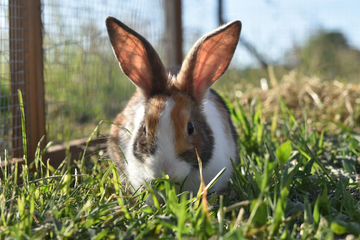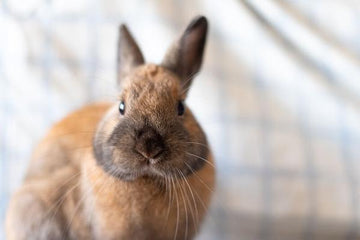Bunny Hay Tips – What to Feed Your Small Pet
As a new rabbit owner, you want to provide the best rabbit care possible. Yet, just like with any new bun parent, you might not be too sure of what kind of hay you should be feeding them along with how much water and treats to be offering them throughout the day.
Click Here For a Guide to Understanding Your Rabbits Diet.

Surprise! The largest part of your rabbit’s diet should be hay – not pellets or carrots. To help make your transition into new parenthood easier, we’ve compiled a list of the all the necessary rabbit feeding tips that will help you start this new adventure off right!
Hay
Proper rabbit care always involves high quality hay, starting with Alfalfa Hay at around three weeks of age and by the time your rabbit hits seven months old, they should be feeding on Timothy Hay. Other grass hays, like Orchard Grass, work if your rabbit doesn’t like Timothy or you find yourself allergic to it. Alfalfa Hay is high in protein, which is great for growing baby bunnies but can cause obesity if they are not moved off of it as their main source of hay as they get older. Timothy Hay and other grass hays are best for rabbits as they age because it doesn’t cause them to gain weight and also provides the right amount of nutrients to keep your rabbit happy and healthy. The PDSA suggests that you feed your rabbit, “at least their own body size in good quality hay each day (it’s best to allow constant access to clean, good quality hay that is not part of their bedding).” Once your rabbit has reached seven months of age, they should be given an unlimited amount of grass hay and should be at least 80% of their diet.
See Also: The Best Rabbit Hay to Keep Your Rabbit Healthy and Thriving
Water
Water is a very important part of your rabbit’s diet. While hay is also important, fresh and clean water should be provided to your rabbit at all times. You can give them easy access to water whenever they are thirsty by using a shallow bowl or water bottle next to their constant access of hay.
Pellets
While many websites suggest different ideas when it comes to feeding your rabbit pellets, the House Rabbit Society summarizes with, “Give limited pellets. Always measure. Don’t overfeed.” They suggest that when feeding pellets, they should be no more than 20% of their diet and only high fiber pellets. Keep in mind, when you’re buying pellets they normally do not stay fresh longer than six weeks, so if your rabbit seems to be looking past their pellets that could be why. It’s also recommended that you feed your rabbit pellets as a treat if you are trying to train your rabbit. Most rabbits tend to like pellets more than they like hay, so this is a great incentive.
Vegetables
When feeding your rabbit vegetables, it is recommended that you feed them as treats (much like pellets) for healthy rabbit care. House Rabbit Society suggests that you look for a variety of both dark leafy vegetables and root vegetables. Make sure to slowly introduce new vegetables to your rabbit over time to ease them into the new food. Watch out for vegetables that are not good for rabbits such as rhubarb and beans. The following is a list of healthy vegetables that could be fed to your rabbit but should still be fed in small amounts according to House Rabbit Society:
Leafy Greens 1 (that need to be rotated due to oxalic acid content and only 1 out of three varieties of greens a day should be from this list):
Spinach
Parsley
Radish tops
Click to read the full list of Leafy Greens 1 and how much you should feed your rabbit.
Leafy Greens 2 (low in oxalic acid):
Carrot tops
Romaine lettuce
Raspberry leaves
Wheat grass
Red or green lettuce
Mint
Basil
Click to read the full list of Leafy Greens 2 and how much you should feed your rabbit.
Fruits
Fruits can be fed to your rabbit, but they are not recommended over vegetables. If you do feed your rabbit fruits, they should make up a very small portion of your rabbit’s food throughout the day. Be sure to thoroughly wash the fruit you feed your rabbit to remove the pesticides that the fruit may have on the outside skin. Berries, bananas, melons, kiwis, and plums are just a few fruits that rabbits are able to eat.
For a larger list of fruits your rabbit can eat, click here.
Recap
The two most important items in your rabbit’s diet should be grass hay (like Timothy Hay or Orchard Grass) and water. Clean water should be provided for your rabbit at all times and hay should be given in an unlimited amount once they’ve hit seven months of age. If you do feed your rabbit pellets, vegetables, or fruits, make sure to keep them at a minimum and think about using them as special treats rather than normal food.
A nutritious and balanced diet is a significant part of practicing good rabbit care to keep your small pet happy and healthy. To learn more about rabbit care and what hay to feed your rabbit, download our free Guide to Understanding Your Rabbit’s Diet below!

Rabbit Is It Low Maintenance or More Work Than You Think?

Signs of Rabbit Health: What You Should Know

Decoding Bunny Behavior: Understanding Rabbit Mood







